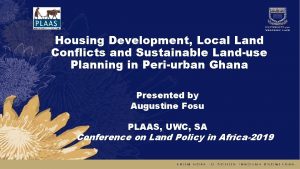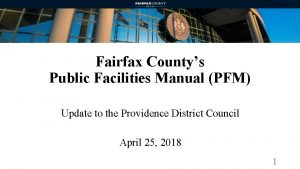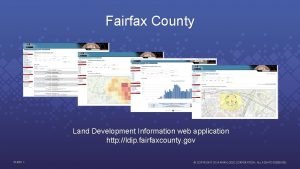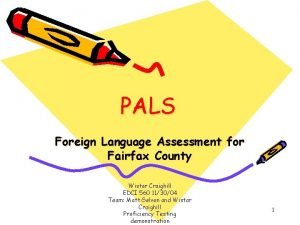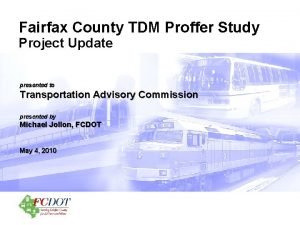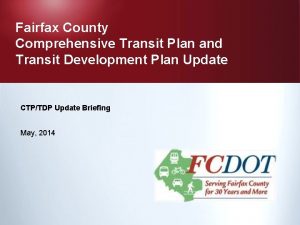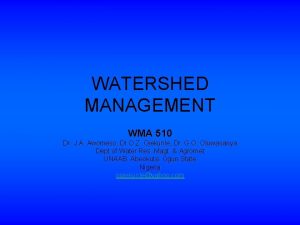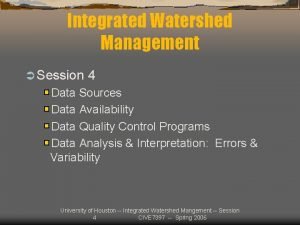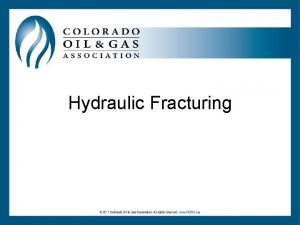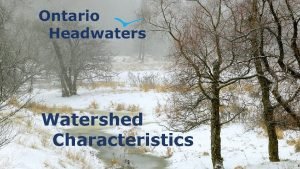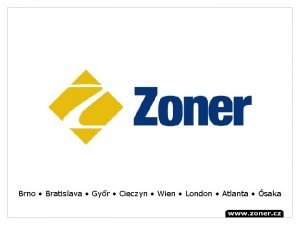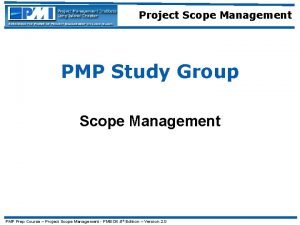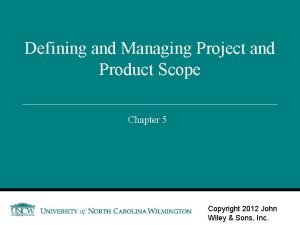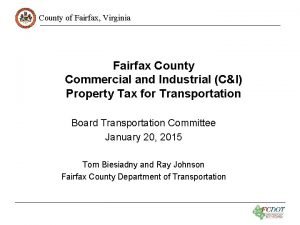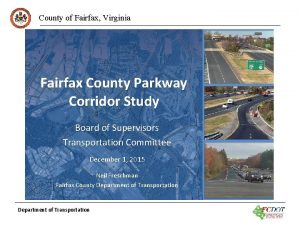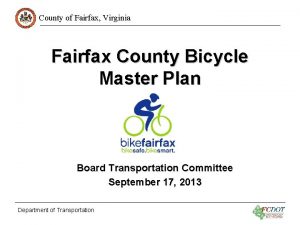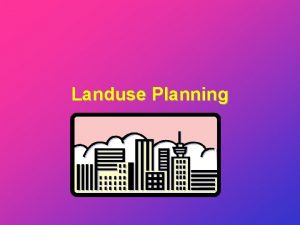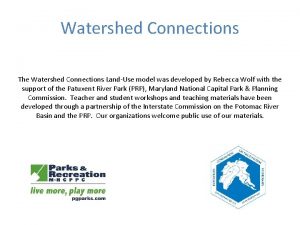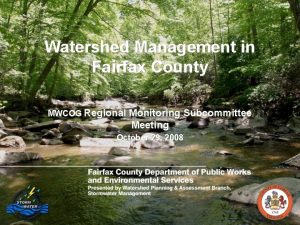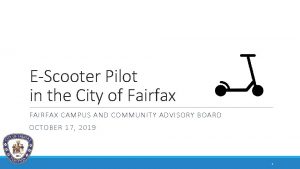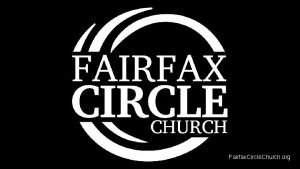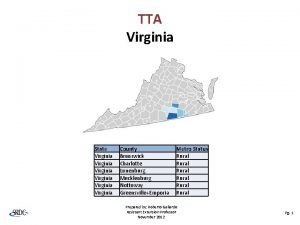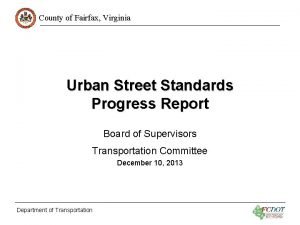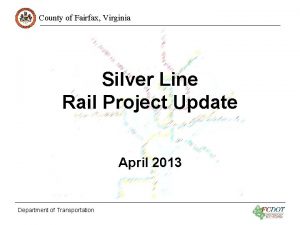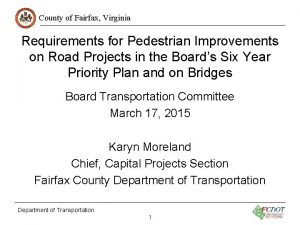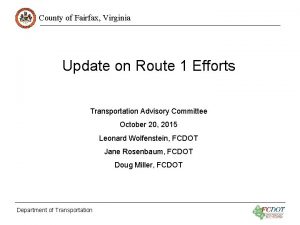Landuse Fairfax County Virginia Watershed Management Plans Scope
















- Slides: 16

Landuse Fairfax County, Virginia Watershed Management Plans

Scope of task � Develop countywide land use/ land cover GIS data layers useful for plan development ◦ Watershed characterization (i. e. maps, data analysis) ◦ Pollution & Hydrologic modeling � Key requirements: ◦ A layer containing a land use mix for both existing and future conditions �Key parameter for modeling water quality ◦ A layer containing Impervious values (connected & disconnected) for both conditions �Key parameter for modeling water quantity

Available digital data � Tax Administration real estate records ◦ Each record contained a unique code for each parcel: �Existing land use Codes > 200 types �Zoned land use � Adopted land use comprehensive plan ◦ Polygons containing planned land use information ◦ Twenty-two different planned land use categories � Parcel data ◦ Polygons contained a unique ID for each parcel ◦ Included vacant & underutilized parcels � Planimetric data (1997 aerial photography)

Consolidation � The need to simplify (i. e. group) land use types through consolidation was evident ◦ 200 different codes (included embedded towns) ◦ Code numbering convention facilitated consolidation

Consolidation � Grouped existing, zoned & planned land use types into 11 categories: � Miscellaneous: �OS - Open Space �GC - Golf Course �INT - Institutional: �Government/Universities �IND - Industrial �Airports �Railways Transportation: �TRANS - Road rights-of-way

Creating landuse layer - a GIS exercise Existing conditions: � Each real estate record was assigned a category for existing, zoned & planned land use � Joined the tabular tax record data to the parcel layer polygons � Included category: TRANS landuse ◦ Areas outside of the parcel boundaries = ROW � Included category: WATER land cover ◦ Planimetric data of the stream network, lakes

Creating landuse layer - a GIS exercise Future conditions: � Intersected comprehensive plan coverage with the parcel layer ◦ Most parcels were already built-out � Vacant & underutilized parcels ◦ Compared zoned vs. planned land use ◦ Where different, chose classification that yielded the greatest density

Creating landuse layer - a GIS exercise Existing conditions - Tysons Corner

Creating landuse layer - a GIS exercise Future conditions - Tysons Corner future

Estimating imperviousness values � Used planimetric data ◦ Features were assigned a corresponding % imperviousness �Buildings, roads, parking lots & sidewalks/trails – 100% �Parking lots, unpaved – 50% �Areas outside planimetric features – 0% � Feature types sampled to estimate the typical DCIA/NDCIA split ◦ Roads, parking lots – 100% DCIA ◦ Sidewalks/trails – 85% DCIA, 15% NDCIA ◦ Buildings – DCIA varied by type �Commercial - 100% �Industrial - 95% �Multi-Family Residential - 90% �Single Family Residential - 50%

Estimating imperviousness values Planimetrics - Tysons Corner

Estimating imperviousness values � Estimating exist & future condition imperviousness values by land use: ◦ Sampled planimetric data in areas representative for each land use category ◦ Average % imperviousness was calculated for each land use category ◦ Assigned % DCIA/NDCIA to each category based on appropriate feature types � DCIA & NDCIA values were aggregated to a “subbasin” level ◦ Polygons were created for modeling purposes ◦ Typically 300 -500 acres in size ◦ Over 1800 polygons

Estimating imperviousness values Existing % Imperv by Land use - Tysons Corner

Estimating imperviousness values Future % Imperv by Land use - Tysons Corner

Conclusion/Challenges � The LU/LC methodology Fairfax County implemented for its watershed planning effort worked well at the local scale & could be a method used to help standardize urbanized LU/LC categories across the bay watershed. � Many smaller jurisdictions have less readily available data, however; many larger urban areas maintain data similar to Fairfax (i. e. comp plan, tax/parcel information & planimetrics) which could be used with this methodology.

Questions?
 Sustainable landuse
Sustainable landuse Fairfax county pfm
Fairfax county pfm Ldip fairfax county
Ldip fairfax county Pals rubric level 1 speaking
Pals rubric level 1 speaking Fairfax county alerts
Fairfax county alerts Fcps calendar
Fcps calendar Fairfax county public facilities manual
Fairfax county public facilities manual Fairfax county comprehensive plan
Fairfax county comprehensive plan Watershed management meaning
Watershed management meaning Integrated watershed management
Integrated watershed management Watershed management
Watershed management Water resource
Water resource Characteristics of a watershed
Characteristics of a watershed Atlanta watershed management
Atlanta watershed management Northern virginia seo
Northern virginia seo Process scope definition
Process scope definition Use case diagram
Use case diagram
